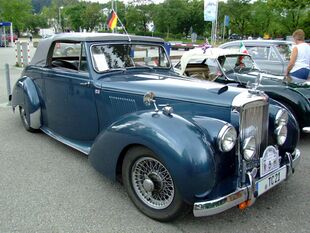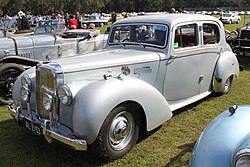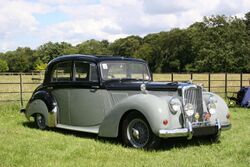Engineering:Alvis TC 21
| Alvis Three Litre TC 21 | |
|---|---|
 TC 21 100 Grey Lady drophead coupé | |
| Overview | |
| Manufacturer | Alvis Cars |
| Production | 1953–1955 757 produced[1] |
| Body and chassis | |
| Body style | 4-door saloon 2-door drophead coupé |
| Layout | FR layout |
| Powertrain | |
| Engine | 3.0 L I6 |
| Transmission | 4-speed manual |
| Dimensions | |
| Wheelbase | 111.5 in (2,832 mm)[2] |
| Length | 182 in (4,623 mm)[2] |
| Width | 66 in (1,676 mm)[2] |
| Height | 62.5 in (1,588 mm)[2] |
| Chronology | |
| Predecessor | Three Litre TA 21 |
| Successor | Alvis TC 108G |
The Alvis Three Litre, TC 21 is an automobile produced by British manufacturer Alvis between 1953 and 1955. An updated version of the Three Litre TA 21, it was available as a 4-door saloon and, in its later TC 21/100 form, also as a 2-door drophead coupé.
TC 21
Body
The TC 21 was available as four-door saloon but, unlike its TA 21 predecessor, no drophead version was offered.[3] The bodies were made for Alvis by Mulliners (Birmingham). A sunshine roof remained standard as did "separately adjustable front seats; heater and air-conditioning unit; Trico windscreen washers" drawing the comment from Autocar "In detail fittings . . . this car leaves little to be desired".[4]
Later TC 21s have chromium-plated window frames.[5]
Engine
The 2,993 cc engine was upgraded to produce 100 bhp (75 kW) by modifying the cylinder head and fitting twin SU carburettors. Suspension was the same as the TA 21, independent at the front using coil springs with leaf springs at the rear. The 11 in (279 mm) drum brakes using a Lockheed system were also retained.
However this update found few buyers during a very difficult year for the British Motor Industry and though it remained in the catalogue and continued to be advertised[6] it was in practice replaced by the Grey Lady.
TC.21/100 Grey Lady
The TC.21/100 or Grey Lady announced 20 October 1953 came with a guarantee of a speed of 100 mph resulting from an improved exhaust system and an engine compression ratio raised from 7:1 to 8:1 to take advantage of the availability of better petrol.[7] The final drive ratio was raised from 4.09:1 to 3.77:1.[2] A paired front fog lamp and matching driving lamp became a standard fitting. The bonnet gained air scoops and wire wheels were fitted to try to enliven the car's image. A heater was fitted as standard but a radio remained an expensive option.
Four door saloon and drophead coupé versions were offered.[3]
A saloon version tested by The Motor magazine in 1954 had a top speed of 100.1 mph (161.1 km/h) and could accelerate from 0-60 mph (97 km/h) in 15.4 seconds. A fuel consumption of 20.6 miles per imperial gallon (13.7 L/100 km; 17.2 mpg‑US) was recorded. The test car cost £1,821 including taxes.[2]
Few concessions to fashion trends
Nevertheless, just 18 months later the Times' Motoring Correspondent tested and reported on the Grey Lady under the headline "Few Concessions to Fashion Trends". His opening gambit was that this Alvis was now one of the few British cars that did not look American and, he said, there was little concession to the cult of streamlining beyond the two air scoops in the bonnet. He wrote that spacious internal headroom and wire wheels completed that picture. It was noted the instruments were not in front of the driver but in the centre of the dashboard (instrument panel) and so the speedometer was apt to be masked by the driver's left hand. However the front seats were comfortable and rear seat passengers received padding on the wheel arches surmounted by armrests. Leather upholstery, pile carpets and walnut facings for the dashboard and lower parts of the window frames completed the traditional picture. He did however say that "the driver who is sensitive to the "feel" of his car will enjoy every moment of his motoring irrespective of the traffic" and reported the car's behaviour on corners was extremely stable though potholes like those caused by recessed manhole covers proved very heavy going for the springing.[8]
A Graber-bodied coupe on a TC 21/100 chassis was exhibited at the London Motor Show in October 1955.[9] The similar TC 108G entered limited production the following year.[9]
References
- ↑ Robson, Graham (2006). A-Z British Cars 1945–1980. Devon, UK: Herridge & Sons. ISBN 0-9541063-9-3. https://archive.org/details/azbritishcars1940000robs.
- ↑ 2.0 2.1 2.2 2.3 2.4 2.5 "The Alvis TC 21/100 Saloon". The Motor. February 17, 1954.
- ↑ 3.0 3.1 Michael Sedgwick & Mark Gillies, A-Z of Cars 1945-1970, Bay View Books Ltd, 1989, pages 16 & 17
- ↑ Alvis Three Litre, Display advertising, The Times, Friday, 18 Dec 1953; pg. 11; Issue 52808
- ↑ John Fox, Alvis Cars 1946-1967: The Post-War Years, Amberley Publishing Limited, 2016
- ↑ Display Advertising Alvis Limited. The Times, Thursday, Mar 04, 1954; pg. 5; Issue 52871.
- ↑ The Times, Tuesday, Oct 20, 1953; pg. 5; Issue 52757
- ↑ Traditional Features Of The Alvis "Grey Lady". The Times, Tuesday, 5 Jul 1955; pg. 5; Issue 53264
- ↑ 9.0 9.1 Rara Avis, alvisarchive.com Retrieved 23 July 2016
Further reading
- Clarke, RM (1989). Alvis gold portfolio 1919–1967. Cobham, Surrey, England: Brooklands Books. ISBN 978-1-870642-84-2.
- Culshaw, D (2003). Alvis three litre in detail: TA21 to TF21 1950-67. Beaworthy, Devon, England: Herridge and Sons Ltd.. ISBN 978-0-9541063-2-4.
 |



